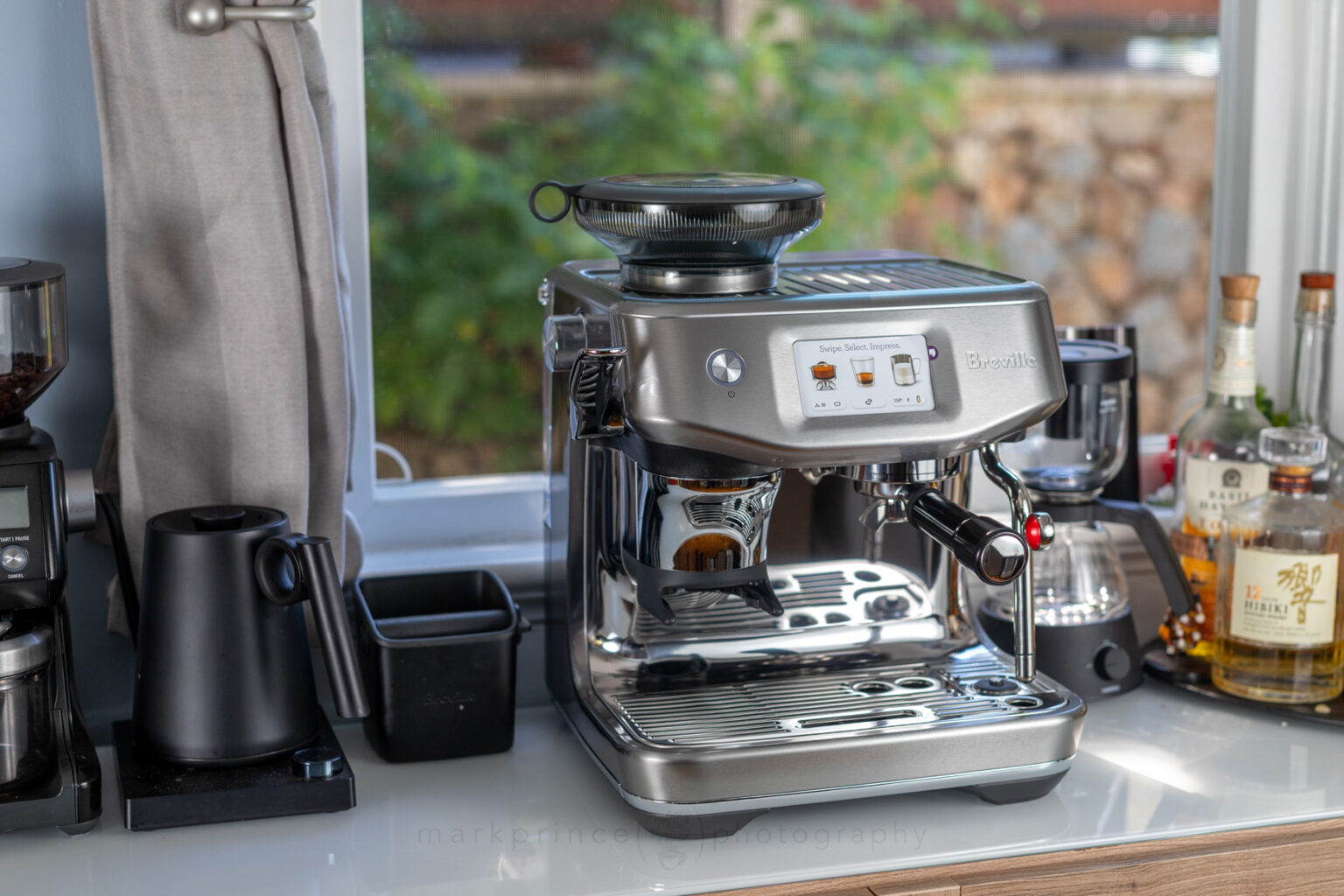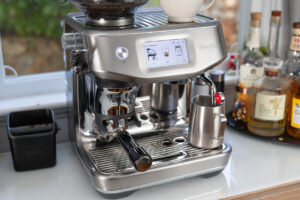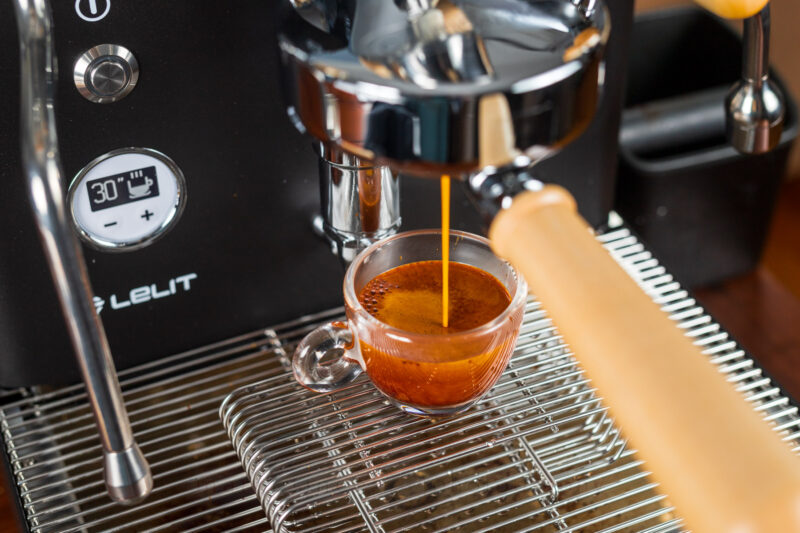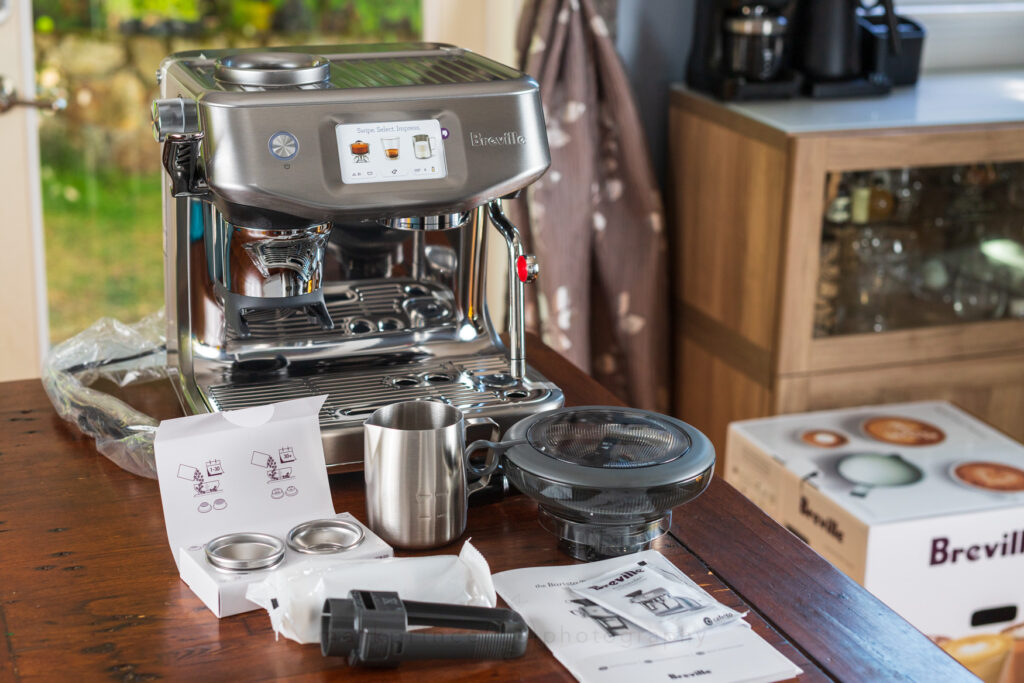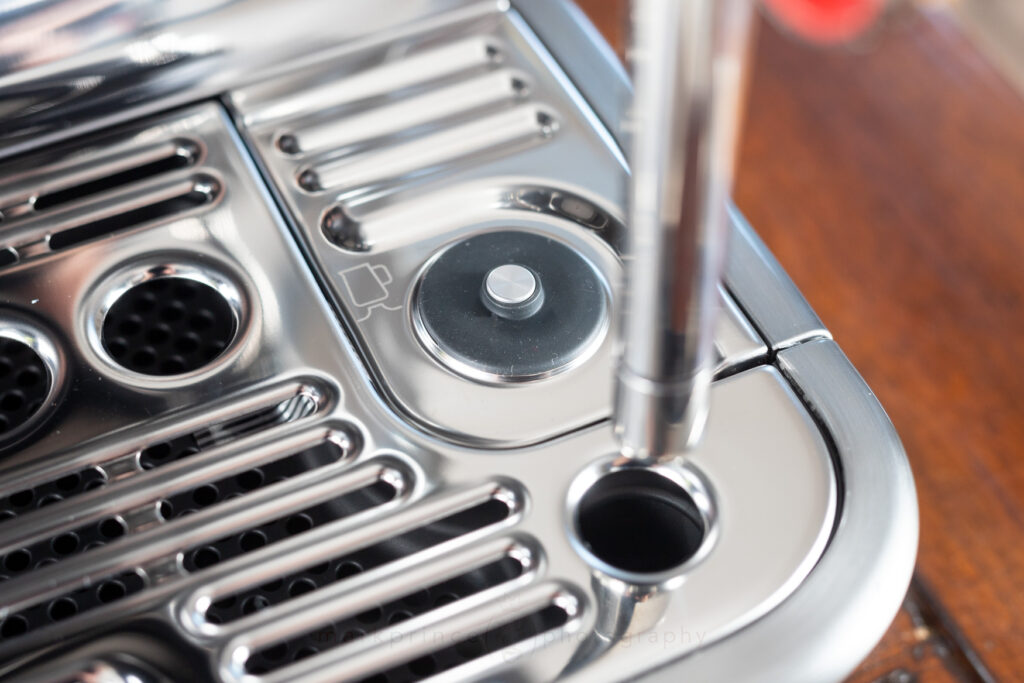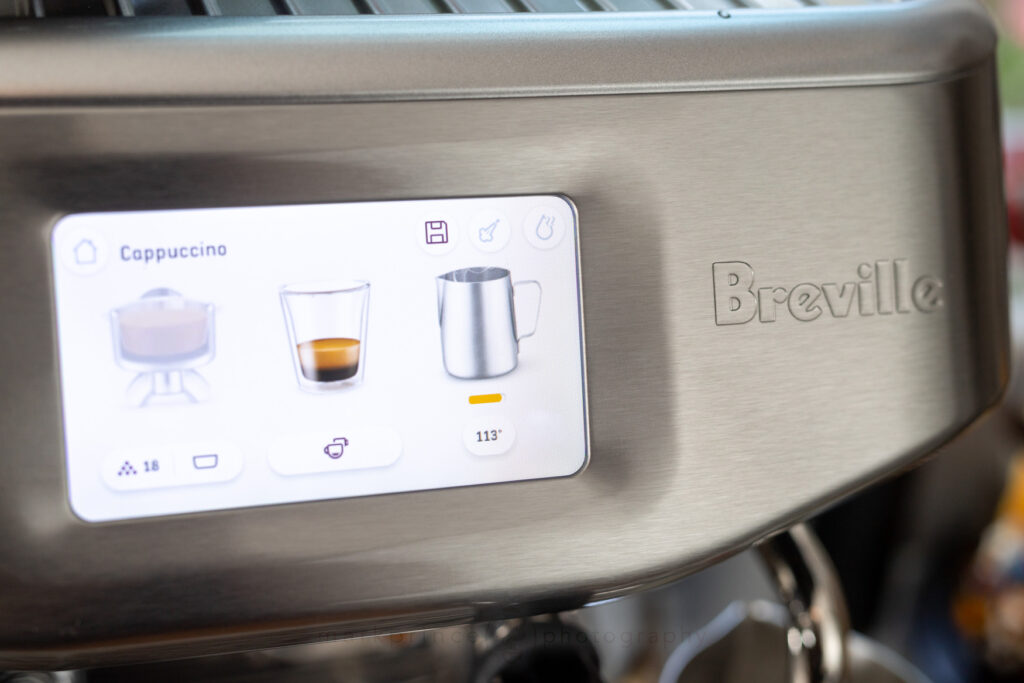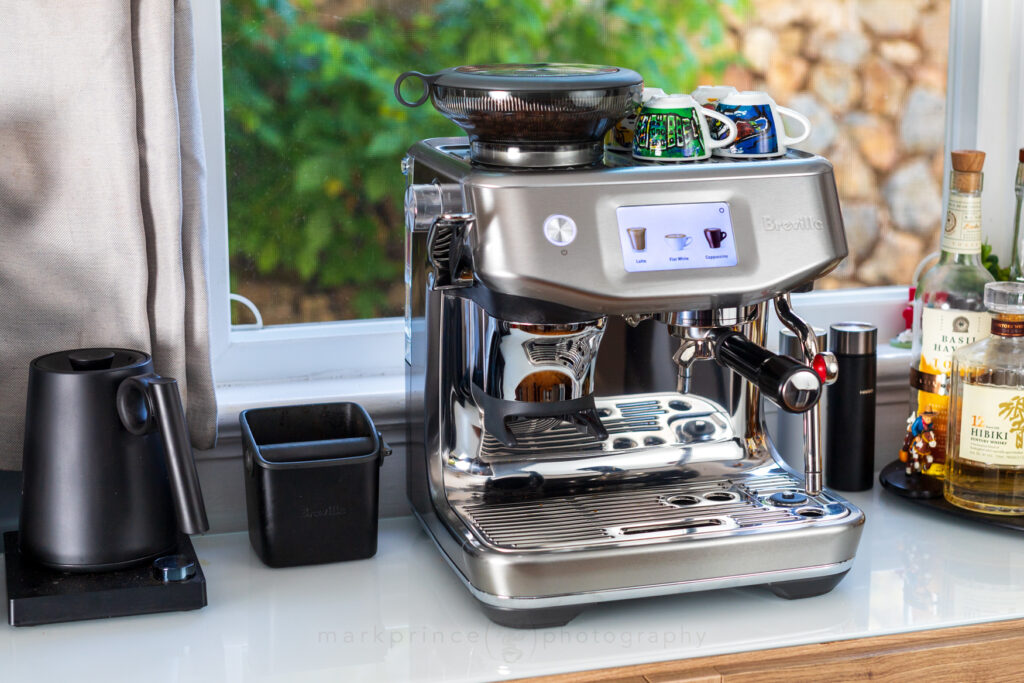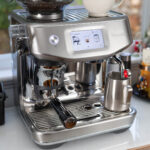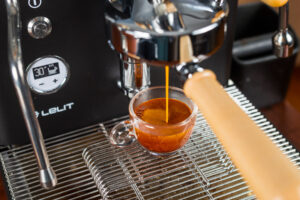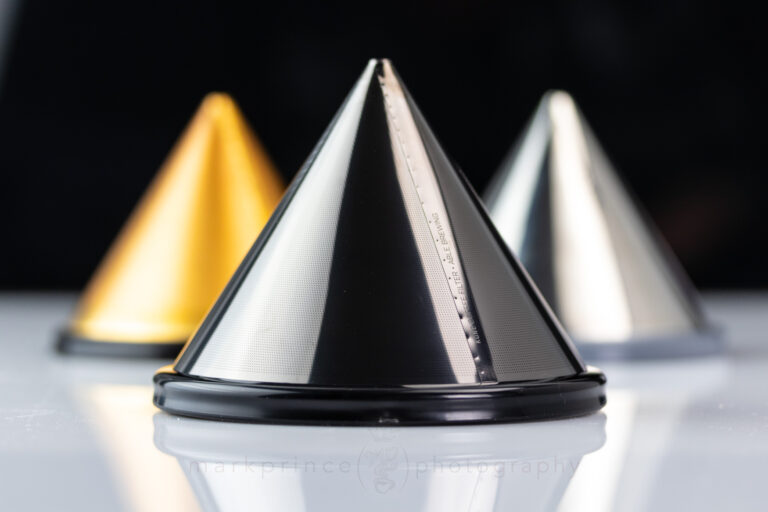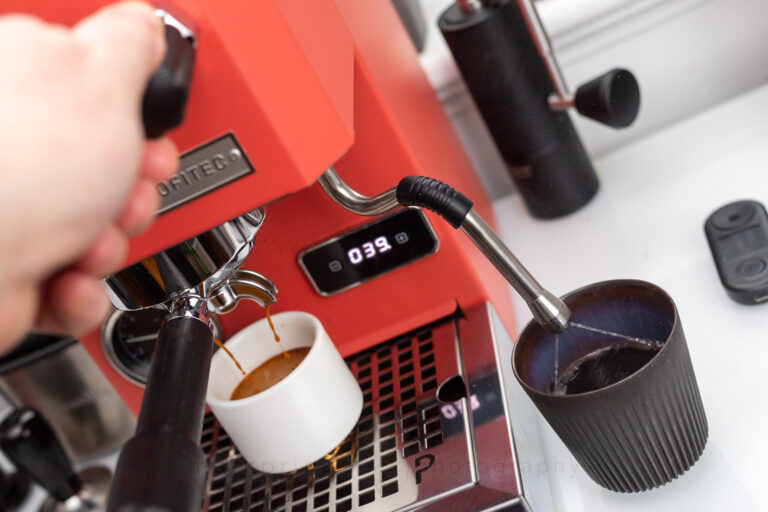Famous appliance and espresso brands like Gaggia, Saeco, Krups, Delonghi, and Philips make a class of espresso machines called “Super Automatics”. This class of machine handles everything from grinding and dosing, to temperature management, brewing and puck ejection. More expensive models can also automatically steam and heat milk from a reservoir for milky drinks.
Super automatics have some serious downsides, which is why we don’t review them on CoffeeGeek. The espresso some produce is middling at best, due to technical and design choices, like the puck size and plastic components affecting internal temperatures. Additionally, they can be mechanically and electrically complex, leading to frequent breakdowns requiring costly repairs. Cleaning them thoroughly is also a hassle. Nevertheless, they do offer convenience, along with a higher price tag.
Breville is one major name in consumer appliances that does not make super automatics.
Instead, Breville has automated traditional espresso machines to varying degrees. The Bambino Plus automates milk frothing while allowing for traditionally prepared espresso shots. The Barista Touch (used in our Cafe au Lait How To) automates milk frothing and partially automates the process of making other drinks, including hot water dispensing. The Barista Express Impress (first look coming soon!) is a traditional espresso machine with a steam wand and a Barista Assist feature for grinding, dosing, and tamping coffee grounds.
The Oracle and Oracle Touch machines are the top offerings in Breville’s automated traditional machine lineup. The former is based on the Breville Dual Boiler machine, featuring an auto dosing and tamping system, as well as an automated milk heating and texturing system with precise temperature control and froth levels. The Oracle Touch enhances the experience with a full-color touchscreen control and customizable drink options.
These machines revolutionize the “super automatics” category. An Oracle Touch can produce espresso comparable to that made by a skilled barista using a high-end dual boiler espresso machine. It does so by automating most steps involved in creating drinks like americanos, cappuccinos, lattes, and macchiatos.
The difference maker is that Breville builds these “super automatic” like technologies around traditional espresso machines. 58mm portafilters (or 54mm in the Barista and Bambino lineups), using their quality Smart Grinder Pro grinder with tweaks. You still move a portafilter from the grinder to the grouphead. You still have the option to control the shot volumes. You still finish your milk builds by pouring (and perhaps creating latte art as well). You dump the puck after and rinse the grouphead. And these machines are way easier to clean than traditional super automatics.
The Oracle at $2,200, and the Oracle Touch at $2,700 are the pinnacles of Breville’s automated barista mode machines. But those prices can be hard to justify for many. That’s why Breville designed a new machine to deliver most of what the Oracle Touch can do, but at $1,100 less expensive.
In the past few weeks, Breville has rolled out their brand new Barista Touch Impress (BBTI) machine. We’ve got one, and we’re going to give it the full first look and review process. For now, here’s an introduction to what the machine is.
The Breville Barista Touch Impress
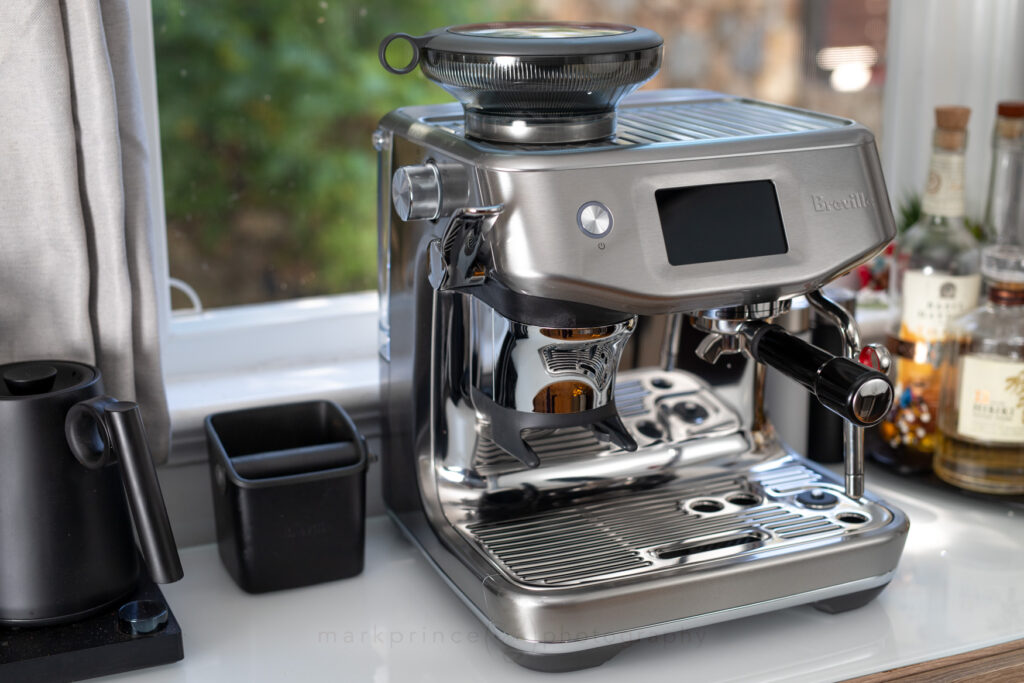
The Barista lineup from Breville has a wide range of machines, fronted by the Barista Express, the world’s best selling espresso machine for 12 years now. No wonder why: it’s a complete grinder and espresso machine combo that punches way above its weight class, with controllable PID controls, OPV valve (recently tweaked by Breville for better performance), overpressure valves, and quick transitions from brewing to steaming. Other excellent features include a pressure gauge up front, controllable pre-infusion, a big reservoir and drip tray, and volumetric, programmable shot volumes. All for a machine that retails as low as $600 when on sale.
The latest entry in the Barista lineup is a bridge machine between the Barista line and the Oracle line: the Barista Touch Impress machine. The feature list is staggering, and it even does some things the flagship Oracle Touch machine cannot do.
The Bones of the Barista Touch Impress
Before I get into the gee-wizardry of the Touch Impress’ breakout features, let me talk about the bones of the machine. It uses the latest variant of Breville’s new instant-on thermojet system, first seen in the Bambino Plus and Barista Touch models. 3 seconds after you turn the machine on, it’s ready to brew (at least the internal water temperatures are set). Want to steam milk? 3 second transition time to that mode. PID controlled, and you can set the brewing (and steaming) temperatures.
The grinder is still based around the Smart Grinder Pro design, but with one important upgrade. This is the first machine from Breville using Baratza’s custom burrs milled by Etzinger. They’re using the M2 burrset designed to give espresso grinding a boost, and are the same burrs used in the Baratza Virtuoso+ and the new Encore ESP.

They are a nice step up from the previous burrs Breville used in all their other machines, and those burrs were pretty good to begin with. The hopper is now a larger diameter than other Barista models, and capable of holding a full 12oz of coffee. There’s also 30 grind settings to choose from (our review will determine how many of those are suitable for different espresso styles).
The body is Breville’s standard brushed steel shell with a steel and plastic set of internals, but it has a more curvy design than the other machines in the Barista lineup. It still features the nice big water reservoir (2l, or 67fl.oz), big drip tray (a bit smaller than the Barista Express, to accommodate the MilQ automated system), large cup area up top, and the entire machine weighs in at just under 11kg.
The machine comes with the usual assortment of Breville’s generous accessories. You get four filter baskets (two are pressurized); a water filter system; a starter set of cleaning tabs and blind filter; cleaning brushes and steam wand tool; the lovely and weighty 54mm steel double spout portafilter; and a good quality 480ml milk frothing jug. The Barista Touch Impress does not come with a tamper like other Barista machines do. Because, well, you know.
The Gee-Wizardry of the Barista Touch Impress
There are four key components that break big ground in espresso machine technology on the Breville Barista Touch Impress:
- The Barista Assist dosing and tamping system
- The Auto MilQ system which is probably the best automated milk system to date by Breville
- The touchscreen controls and visuals, also upgraded compared to the Barista Touch
- The software that runs it all
Let’s tackle each, briefly.
Barista Assist Grinding, Dosing and Tamping
The Barista Assist system first showed up on the Breville Barista Express Impress machine, with a bit more of an analog display approach to a nicely designed automatic dosing and tamping system. You’re involved by pulling down (twice, for polish) on a lever. It works very well on the Barista Express Impress (BBEI) machine, which we’ll detail in our forthcoming First Look for that brewer (way overdue!).
The system has sensors for the dosing levels, but also uses software to automatically adjust the grinding time next use, learning from the previous dosing session. If too little coffee was in the portafilter the first time you use it on a given day, the next time you use it, it would add a bit of grinding time to compensate.
The Barista Assist mode is taken up a notch or two on the BBTI via the full colour touchscreen controls. On top of providing more visual feedback on dosing and when it’s too little or too much, the machine also coaches you on ways to improve the dose and grind selection.
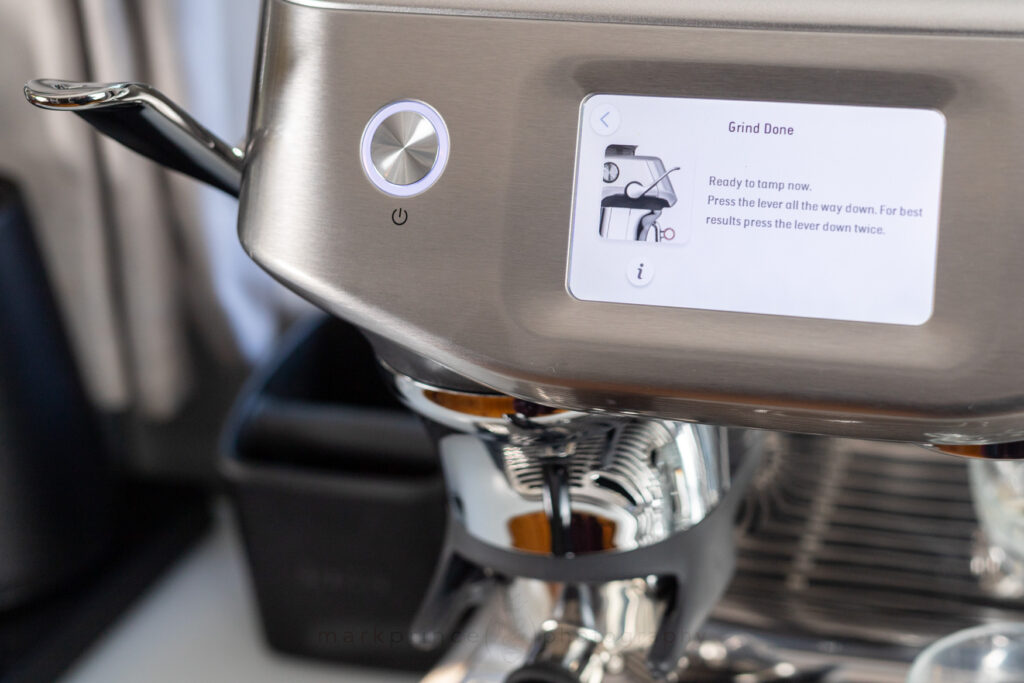
This system automates one of the most frustrating elements many people have with traditional espresso preparation. And it does it very well, providing a consistent 10kg tamping pressure and a slight turn to “polish” the puck.
The Auto MilQ System
Brevlle’s been automating milk heating and texturing for nearly 8 years now, starting with the Oracle machine. In that time, it’s been refined and improved. While the BBTI machine doesn’t have the Oracle’s crazy expensive internal temperature probe sensing steam wand (the BBTI reads milk temperature via a sensor the milk pitcher sits on), it has improvements over the Oracle in terms of what kind of liquid you choose to steam.
That’s because this is their first machine with dedicated modes for dairy milk and plant-based “milks” like oat, soy and almond. Skilled baristas know these liquids steam and froth differently from dairy milk, and this machine compensates for those liquids, just like a real barista does.
The Auto MilQ system also has a wider range of texturing / frothing levels, and a wider range of set liquid temperatures, equalling the Oracle Touch in this regard, and surpassing the Bambino Plus, Barista Touch and even the original Oracle. Like all of Breville’s automated milk systems, the one on the BBTI textures nearly perfect microfoam and the volumes and temperatures you select.
Lastly, even though this is a “single boiler” (well, single thermojet) machine (meaning you can’t heat milk and brew an espresso shot at the same time, like you can on the Oracle), the Auto MilQ system can be set to automatically (and immediately) steam your milk as soon as your espresso is done brewing. This means you can prep your shot pull, put the milk pitcher (with milk inside) under the steam wand, press the screen image of the steam pitcher, and walk away. Come back 75 seconds later, and you have a completed shot, and textured and heated milk, ready to pour.
Touch Screen Controls
The Breville Barista Touch Impress has Breville’s latest and improved full colour LCD screen and a more intuitive, visual feedback system; it’s better than the already excellent screens and visuals on the Barista Touch and Oracle Touch. Everything seems crisper and the animations are more relevant to what’s actually going on. There’s also a lot of live feedback (this is the fourth big breakthrough, covered below in software) that can make even beginning coffee makers into learning baristas.
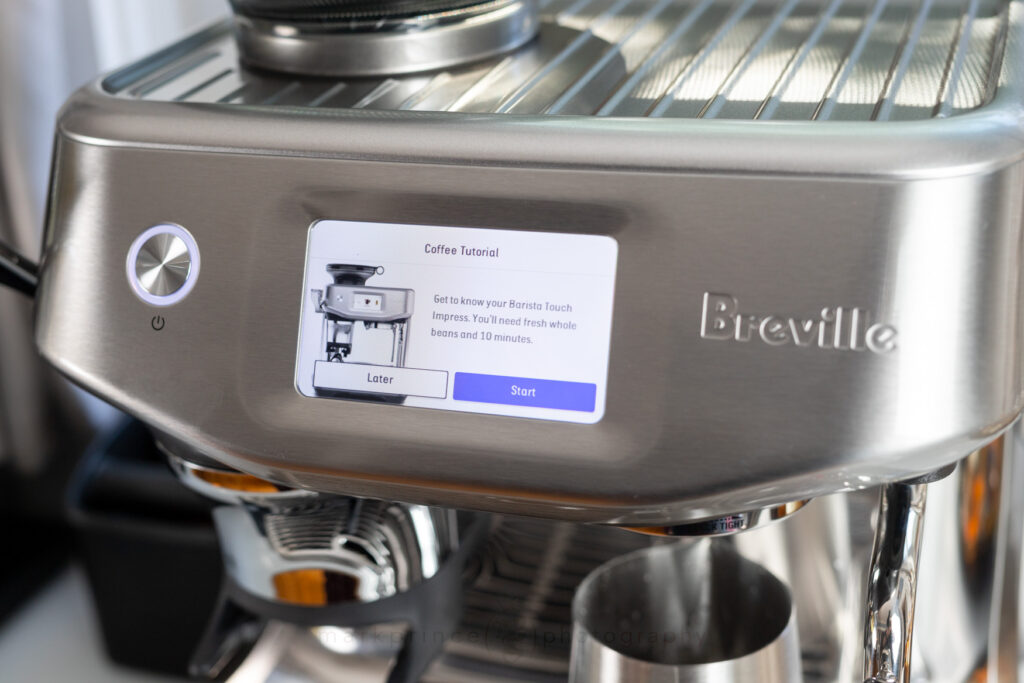
Everything the machine does (except for adjusting the grind fineness) is controlled through the touchscreen, including activating the grinder, dose adjustments, drink builds, customized drink recipes, machine operating temperatures and more. It’s a visual feast, with complete hand-holding for those who need it.
The Software
When we do our First Look and Full review, the software system in the Barista Touch Impress is going to get a lot of attention. Because Breville gave it a lot of attention. In many ways it is more advanced than the Oracle Touch’s system. Not only does it completely aid you through the entire process of building a variety of beverages based on espresso, but it also provides on the fly tips, almost as if by AI (nb, there’s no AI in this machine, save for some rudimentary stuff, like auto adjusting grinding dose if too little coffee is in the portafilter).
One feature I noticed right away: it recognizes if you’re under or over extracting your espresso shots, and makes suggestions on screen for how to fix that for the next shot pull.
The drink menu is nice and varied, and you can program in your own custom drinks as well, which will automatically appear the the start of the side scroll list of drinks.
One thing I’m not sure yet on is if you can turn off the hand holding features if you feel you’re are an advanced enough home barista to not require the assist modes. I’ll find out for the First Look.
Conclusion
All in all, an impressive technological machine from Breville, this Barista Touch Impress. At least on paper. Automated (and auto-correcting) dosing and tamping. Automated, wide variety of drink builds. Automated milk heating and texturing. More assist modes on screen to help you learn and make better espresso. Instant on. Instant frothing and heating. All built around a traditional espresso machine. And all for $1,500, which is substantially less than super automatics with automated milk systems.
We’re fast tracking our First Look for this machine, which will include some initial use and a deeper dive into some of the machine’s abilities and functions. Look for that some time in early August this year.
If you can’t wait, and think this machine might be perfectly suited for your home and the folks in your life who love espresso, consider buying it from a CoffeeGeek supporter company, like Whole Latte Love. It also helps if you tell them where you heard about this machine in the comment section of their purchase page. This can go a long way to helping our website continue to bring you new and interesting content.
Mark has certified as a Canadian, USA, and World Barista Championship Judge in both sensory and technical fields, as well as working as an instructor in coffee and espresso training. He started CoffeeGeek in 2001.
-
Mark Princehttps://coffeegeek.com/author/markprince/May 6, 2024
-
Mark Princehttps://coffeegeek.com/author/markprince/April 30, 2024
-
Mark Princehttps://coffeegeek.com/author/markprince/April 29, 2024
-
Mark Princehttps://coffeegeek.com/author/markprince/April 28, 2024

